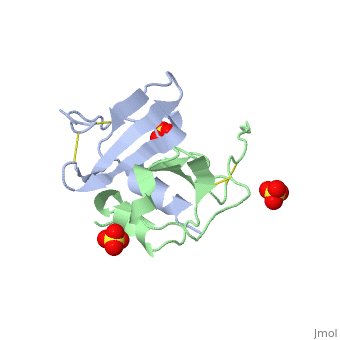1qg7
From Proteopedia
STROMA CELL-DERIVED FACTOR-1ALPHA (SDF-1ALPHA)
Structural highlights
FunctionSDF1_HUMAN Chemoattractant active on T-lymphocytes, monocytes, but not neutrophils. Activates the C-X-C chemokine receptor CXCR4 to induce a rapid and transient rise in the level of intracellular calcium ions and chemotaxis. Also binds to another C-X-C chemokine receptor CXCR7, which activates the beta-arrestin pathway and acts as a scavenger receptor for SDF-1. SDF-1-beta(3-72) and SDF-1-alpha(3-67) show a reduced chemotactic activity. Binding to cell surface proteoglycans seems to inhibit formation of SDF-1-alpha(3-67) and thus to preserve activity on local sites. Acts as a positive regulator of monocyte migration and a negative regulator of monocyte adhesion via the LYN kinase. Stimulates migration of monocytes and T-lymphocytes through its receptors, CXCR4 and CXCR7, and decreases monocyte adherence to surfaces coated with ICAM-1, a ligand for beta-2 integrins. SDF1A/CXCR4 signaling axis inhibits beta-2 integrin LFA-1 mediated adhesion of monocytes to ICAM-1 through LYN kinase. Inhibits CXCR4-mediated infection by T-cell line-adapted HIV-1. Plays a protective role after myocardial infarction. Induces down-regulation and internalization of CXCR7 expressed in various cells. Has several critical functions during embryonic development; required for B-cell lymphopoiesis, myelopoiesis in bone marrow and heart ventricular septum formation.[1] [2] [3] [4] [5] [6] Evolutionary ConservationCheck, as determined by ConSurfDB. You may read the explanation of the method and the full data available from ConSurf. Publication Abstract from PubMedCrystal structures, forms 1 and 2, of recombinant native stromal cell-derived factor-1alpha (SDF-1alpha), expressed using the Sendai virus expression vector system, have been determined by x-ray crystallography at 2.0 A resolution. The crystal of form 1 is almost isomorphous with that used in the previous crystal structure analysis of the synthetic [N33A] mutant of SDF-1alpha (Dealwis, C., et al. Proc. Natl. Acad. Sci. USA 1998;95, 6941-6946). However, the present structure analysis led to considerably better refinement statistics, revealing an error in the structural assignment of N-terminal residues in the previous report. Comparison of the solution structure, as previously determined by nuclear magnetic resonance (NMR) spectroscopy, and the present structure, with two monomers in the asymmetric unit, reveals several local conformational differences. Alanine scan mutagenesis studies for each residue in the so-called RFFESH motif revealed that only the first residue, Arg12, is effective in enhancing receptor binding (and successive activation). A new notion that steric restraint between Arg8 and Arg12 is favorable (if not vital) for retaining SDF activities appears to explain more consistently the structure-activity relationship data accumulated to date. Four guiding principles are presented that may be useful for designing potent therapeutic compounds interfering with HIV-1 infection through competition at the CXCR4 coreceptor. Crystal structure of recombinant native SDF-1alpha with additional mutagenesis studies: an attempt at a more comprehensive interpretation of accumulated structure-activity relationship data.,Ohnishi Y, Senda T, Nandhagopal N, Sugimoto K, Shioda T, Nagal Y, Mitsui Y J Interferon Cytokine Res. 2000 Aug;20(8):691-700. PMID:10954912[7] From MEDLINE®/PubMed®, a database of the U.S. National Library of Medicine. See AlsoReferences
| ||||||||||||||||||||


